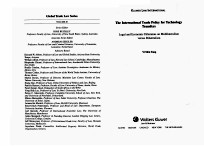
- 作 者:
- 出 版 社:KLUWER LAW INTERNATIONAL
- 出版年份:2009
- ISBN:9789041128256
- 标注页数:124 页
- PDF页数:246 页
请阅读订购服务说明与试读!
订购服务说明
1、本站所有的书默认都是PDF格式,该格式图书只能阅读和打印,不能再次编辑。
2、除分上下册或者多册的情况下,一般PDF页数一定要大于标注页数才建议下单购买。【本资源246 ≥124页】
图书下载及付费说明
1、所有的电子图书为PDF格式,支持电脑、手机、平板等各类电子设备阅读;可以任意拷贝文件到不同的阅读设备里进行阅读。
2、电子图书在提交订单后一般半小时内处理完成,最晚48小时内处理完成。(非工作日购买会延迟)
3、所有的电子图书都是原书直接扫描方式制作而成。
Chapter 1 Introduction 1
1.1 Objectives 1
1.2 Background 2
1.3 Theoretical Relevance and Previous Approaches to the Problem 9
1.4 Method 13
1.4.1 The Legal Method in Public International Law 13
1.4.2 Economic and Institutional Analysis of Law 15
1.4.3 Comparative Law and Economics 17
1.5 Structure and Organization 18
Chapter 2 The Current Scenario of International Transfers of Technology 23
2.1 The Economic Nature of Innovation 23
2.2 Elements and Types of Technology Transfer: FDI and Licensing 30
2.3 The Relevant Players: The Role of Nation-States and TNCs 33
2.4 The Current Participation of Developing Countries in Technology Flows 36
2.5 Theoretical Views on the Current Distribution of Technology Flows 46
2.6 The Grounds for International Cooperation in the Technology Market 50
2.7 Concluding Remarks 59
Chapter 3 The Law and Economics of Intellectual Property in the International Market 61
3.1 IPR as an Efficient Incentive for International Technology Transfers 61
3.2 Advantages of an International System of IPR Protection 69
3.2.1 The Comparison with Domestic Systems 69
3.2.2 Induction of Stronger IPR Protection through International Law 73
3.2.3 Advantages of International IPR Protection from the Firm’s Perspective 76
3.2.4 Specific Legal and Cultural Issues of the International IPR System 77
3.2.5 Efficiencies of International Policies in Combating IPR Infringements 81
3.3 The Principal Types of International Legal Incentives: Bilateral Investment Treaties and Multilateral IPR Agreements 83
3.4 Concluding Remarks 86
Chapter 4 The Legal Structure of the International Regimes on Technology Transfers 87
4.1 The Legal Structure of the Multilateral IPR System 88
4.1.1 Patent Protection under the Paris Convention 88
4.1.2 Trademarks: The Madrid Agreement and the WIPO’s Role 92
4.1.3 Copyrights: The Berne Convention Framework 95
4.1.4 The Impact of Technological Progress on Copyrights: The Rome Convention 98
4.1.5 The TRIPS Agreement 101
4.2 The Normative Structure of a BIT 105
4.2.1 The Standard of Purpose 105
4.2.2 The Scope of Application 107
4.2.3 Conditions of Admission of a Foreign Investment 109
4.2.4 Standards of Treatment of Foreign Investments 111
4.2.5 Repatriation of Capital and Profits 113
4.2.6 Protection from Expropriation and Compensatory Measures 114
4.2.7 Dispute Settlement Mechanisms 116
4.2.8 Temporal Effects 120
4.3 Technology as a Form of Investment under a BIT 121
4.3.1 General Definition of Investment under a BIT 122
4.3.2 Incorporation of IPRs in the Definition of Investment 124
4.4 Concluding Remarks 126
Chapter 5 The Relationship between BITs and Multilateral IPR Agreements 129
5.1 Theoretical Assumptions: State Interest and Rational Choice 130
5.1.1 The State as the Central Actor in International Law 133
5.1.2 Plausibility of the State’s Preferences 134
5.1.3 The Theoretical Framework for the Analysis of States’ Decisions 137
5.2 BITs within the WTO System: Admissibityty of ‘TRIPS-Plus’ Measures 140
5.2.1 Overview of Previous Studies 140
5.2.2 Interpretation of the WTO-TRIPS Agreement on the Legality of BITs 143
5.3 Interactions between Bilateral and Multilateral IPR Agreements 151
5.3.1 Behavioral Models on the Formation of International IPR Agreements 153
5.3.1.1 State Interests in the Technology Market 153
5.3.1.2 Categories of State Behavior in International Trade Relations 155
5.3.1.3 Economic Meaning of an International IPR Treaty in a Multiplayer Environment 162
5.3.1.4 Specific Differences between Multilateral and Bilateral IPR Regimes 164
5.3.2 The Role of BITs in Reducing Transaction Costs in the WTO Forum 169
5.4 Independent Economic Effects of BITs 172
5.5 Influence of BITs in the Development of CustomaryInternational Law 174
5.5.1 The Importance of International Custom for the Technology Transfer Market 174
5.5.2 Treaties as Evidence of International Custom 175
5.5.3 The Traditional Approach to BITs and Customary International Law 180
5.5.4 An Alternative Theory on the Role of BITs 185
5.6 Concluding Remarks 191
Chapter 6 Conclusion 193
Bibliography 195
List of International Cases and Disputes 215
List of Treaties, Statutes and other Official Documents 219
List of Figures and Tables 227
Subject Index 229
